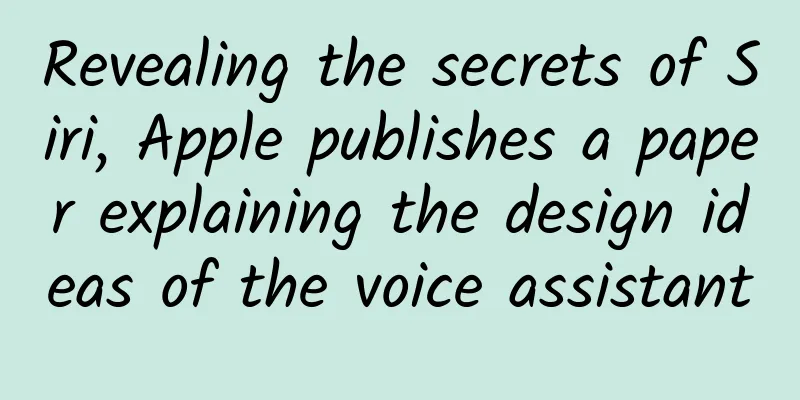Revealing the secrets of Siri, Apple publishes a paper explaining the design ideas of the voice assistant

|
Recently, Apple released a series of papers to explain the important working mechanisms of voice assistants, publicly revealed Siri, and contributed its different design ideas to the industry. In the first paper, Apple explained the multitasking problem in voice assistants, pointing out that in Siri, wake-up processing usually requires two steps: AI must first determine whether the voice content in the input audio matches the voice content of the trigger phrase (voice trigger detection), and then must determine whether the speaker's voice matches the voice of one or more registered users (speaker verification). The general method is to handle the two tasks separately, but Apple believes that a neural network model can be used to solve the two tasks at the same time. At the same time, it said that after verification, the performance of this method in all aspects can meet expectations. In the paper, the researchers gave an example of the model. They trained models designed based on two ideas in a dataset containing 16,000 hours of annotated samples, of which 5,000 hours of audio had voice tags and the rest had only speaker tags. Compared with the general idea of training models to obtain multiple labels, Apple trains models for multiple related tasks by cascading training data for different tasks. It was found that with the same performance, Apple's newly proposed model is more suitable for application. It can share calculations between two tasks, greatly saving memory space on the device, while reducing calculation time or waiting time and power/battery consumption. In another paper, Apple also introduced the design of a speaker recognition system for multilingual speech scenarios - knowledge graph-assisted dictation system decision-making. Taking the acoustic sub-model as an example, it can make predictions based on voice signal transmission traces, and its context-aware prediction component takes into account various interactive context signals, where the context signal contains information about the conditions for issuing commands, installed command language environments, currently selected command language environments, and whether the user switches command language environments before making a request. The results show that the advantage of this design is that they can help in situations where the speech signal is too short to produce reliable predictions through the acoustic model. In addition, Apple also proposed a supplementary study to mitigate the problem of false triggering, that is, ignoring voices that are not suitable for the voice assistant (Siri). Based on the idea of designing AI models based on graph structures, researchers proposed a graph neural network (GNN) in which each node is connected to a label. The results showed that the model reduced false triggers by 87%. |
<<: Can the iPhone still perform facial recognition when wearing a mask?
>>: Apple releases new patent? Can it solve the crease problem of foldable devices?
Recommend
The secrets of the death of smart hardware startups
This article is transferred from: Channel Help Sh...
80% of PS4 players have never seen Drake? Game experience of "Uncharted: Drake Collection"
Since Sony officially announced "Uncharted 4...
Summer "high-end meal": beer + seafood? Learn more about gout →
In the hot summer, beer and seafood seem to have ...
"Is there anything that can't be discussed after the New Year?" These things can't be discussed!
The New Year is coming soon, and people often say...
How to use the points system to stimulate user retention (Part 1): Classification and definition of points
The so-called points system is based on points. B...
Radiation-resistant: New technology opens new avenues for biopharmaceuticals in space flight
The author or source of this article or its origi...
Pagodas suppress sea monsters! The killer of the Ordovician ocean: Sinian hornstone
The New Bride Stone in Nanyan, the thunderbolt pr...
How does Weibo content marketing build IP?
Whether now or in the future, the value and influ...
Mixed infection has occurred! Doctors remind that the popular "three-piece set" for Mycoplasma pneumoniae infection should be used with caution!
Edit: Thanks Autumn and winter are the peak seaso...
Strong winds break records, hail covers the ground! This year's most intense severe convective weather is coming, how to prevent it
Starting from yesterday afternoon (April 11), due...
World Immunization Day | Why is the best medicine in the human body?
Do you have any medicine? Capsules, fish oil, mel...
Xiaohongshu Promotion: After cleaning up KOLs, can we still “plant grass” well?
On May 10, Xiaohongshu announced the "Brand ...
A series of courses on fine-tuning the operation of Doudian's no-source store group, helping beginners with zero foundation to start their own business in Doudian, worth 888 yuan
A series of courses on the refined operation of Do...
After reading Martin Whitman, I realized I was stupid.
Like "Securities Analysis", this is a b...
China Passenger Car Association: The narrow passenger car retail market in November 2022 was around 1.86 million vehicles, a year-on-year increase of 2.4%
According to data from the China Passenger Car As...









